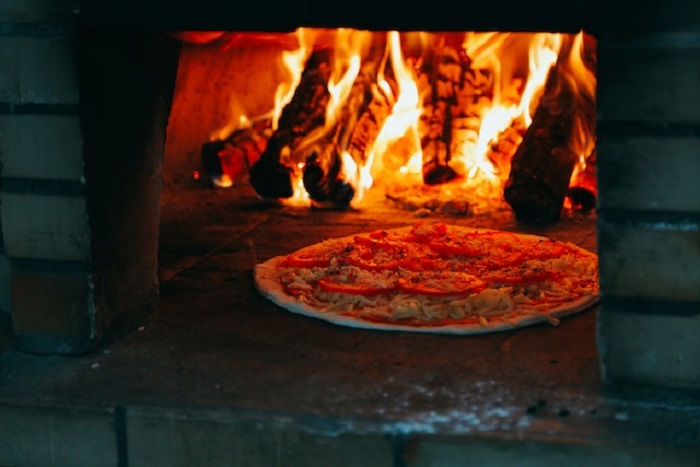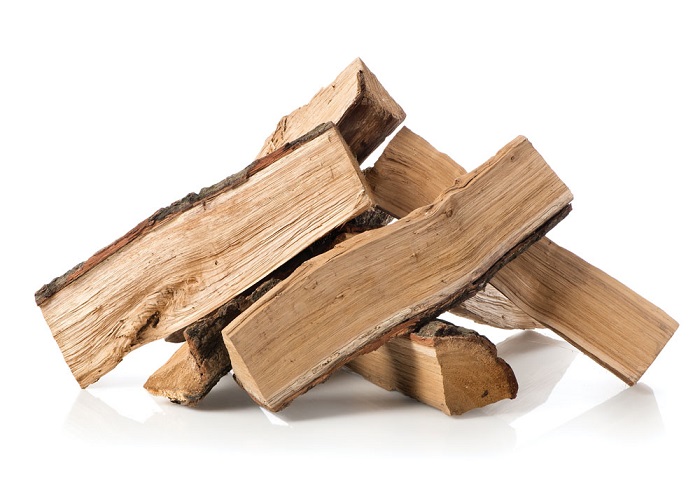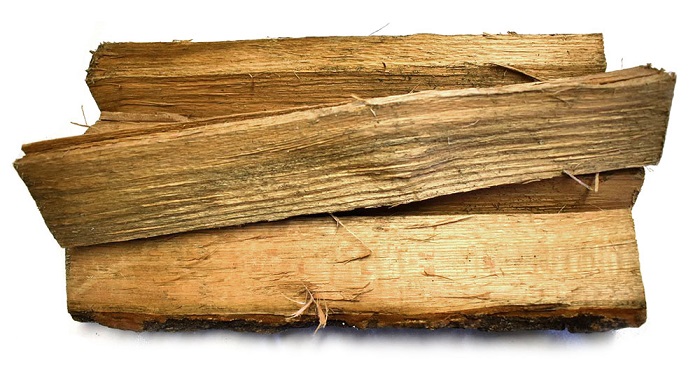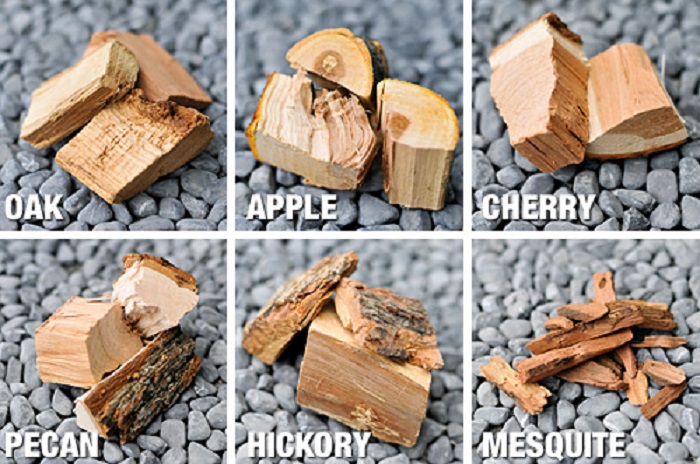TOP 8 BEST WOOD FOR PIZZA OVEN REVIEWS IN 2024.
Unleashing Delectable Flavors: A Guide to the Top 8 Best Wood for Pizza Ovens.
In this comprehensive guide, we delve into the realm of wood-fired pizza ovens and explore the top 8 best wood options to elevate your pizza game. Whether you’re a home cook seeking to replicate the charm of a pizzeria or a seasoned chef aiming to perfect your pie, understanding the characteristics of different wood types is essential.
Get ready to embark on a journey that blends culinary tradition with modern expertise, all centered around the heart of the pizza-making process: the wood that fuels the fire.

TOP 8 BEST WOOD FOR PIZZA OVEN REVIEWS.
1. OAK:
Embracing Tradition: The Distinctive Charms of Oak Wood for Pizza Ovens.
Among the myriad options available, oak wood stands as a timeless choice that has captured the hearts and palates of pizza enthusiasts and artisans alike. With its rich history, exceptional burning properties, and distinctive flavor contributions, oak wood brings a touch of tradition and sophistication to the art of wood-fired cooking. It’s one of Best Wood for Pizza Oven.
Pros:
- Robust Flavor Infusion.
- Consistent and Prolonged Heat.
- Versatility in Pairings.
- Distinctive Aroma.
- Sturdy and Long-Lasting.
Cons:
- Intense Flavor Domination.
2. MAPLE:
Savoring Sweetness: Exploring Maple Wood for Pizza Ovens.
Among the array of wood options available, maple wood emerges as a captivating choice that brings a touch of sweetness to the art of pizza making. It’s one of Best Wood for Pizza Oven.
Pros:
- Subtle Sweetness.
- Moderate and Even Heat.
- Enhanced Flavor Balance.
- Aromatic Ambiance.
- Elegant Finish.
Cons:
- Limited Boldness.
3. CHERRY:
A Symphony of Flavor: Unveiling Cherry Wood for Pizza Ovens.
Among the orchestra of options, cherry wood emerges as a captivating soloist, bringing a melodious blend of aroma and flavor to the forefront of the pizza-making experience. Renowned for its subtly fruity essence and steady burn, cherry wood infuses pizzas with a unique and enchanting character, adding a touch of sophistication to every slice.
Pros:
- Mild Fruitiness.
- Steady and Controlled Heat.
- Aromatic Elegance.
- Complementary Flavor Pairings.
- Enhanced Visual Appeal.
Cons:
- Limited Intensity.
4. HICKORY:
Boldly Smoky and Rich: Exploring Hickory Wood for Pizza Ovens.
With its robust flavor profile and commanding presence, hickory wood elevates the pizza-making experience to a level of complexity that delights the senses and ignites the palate. It’s one of Best Wood for Pizza Oven.
Pros:
- Intense Smokiness.
- Distinctive Aroma.
- Versatile Pairings.
- Enhanced Crust Texture.
- Authentic Outdoor Appeal.
Cons:
- Dominant Flavor.
5. APPLE:
Subtle Sweetness and Aromatic Bliss: Exploring Apple Wood for Pizza Ovens.
Amidst the diverse spectrum of wood options available, apple wood emerges as a captivating protagonist, renowned for its delicate and fragrant attributes. With its gentle infusion of sweetness and aromatic charm, apple wood imparts pizzas with a distinctive character that marries tradition and creativity.
Pros:
- Fruity Essence.
- Aromatic Ambiance.
- Versatile Complement.
- Visual Appeal.
- Elevated Elegance.
Cons:
- Mild Flavor Intensity.
6. MESQUITE:
Bold and Smoky Adventure: Mesquite Wood’s Influence on Pizza Ovens.
With its bold and assertive flavor profile, mesquite wood imbues pizzas with a robust, Southwestern-inspired essence, elevating the dining experience to a smoky and savory adventure. It’s one of Best Wood for Pizza Oven.
Pros:
- Intense Smokiness.
- Aromatic Richness.
- Standout Pairings.
- Distinctive Visual Appeal.
- Memorable Outdoor Experience.
Cons:
- Overpowering Flavor.
7. PECAN:
Nuttiness and Nuance: Embracing Pecan Wood in Pizza Ovens.
With its versatile flavor profile and subtle richness, pecan wood imparts pizzas with a harmonious and complex character that elevates the dining experience to a realm of flavorful nuance. It’s one of Best Wood for Pizza Oven.
Pros:
- Nuttiness Infusion.
- Mild Smokiness.
- Versatile Pairings.
- Aesthetic Appeal.
- Complex Flavor Development.
Cons:
- Moderate Flavor Intensity.
8. ALDER:
Delicate Elegance and Subtle Flavor: Unveiling Alder Wood in Pizza Ovens.
Among the diverse selection of wood types, alder wood emerges as a refined and intriguing option, known for its gentle smokiness and delicate character. With its subtle flavor profile and aromatic charm, alder wood imparts pizzas with a touch of understated elegance that invites exploration of nuanced taste experiences.
Pros:
- Light Smokiness.
- Mild Aroma.
- Versatile Complement.
- Balanced Enhancement.
- Subdued Visual Impact.
Cons:
- Limited Intensity.
Above is Top 8 Best Wood for Pizza Oven Reviews. Now, let’s see some tips and guides on buying Best Wood for Pizza Oven as below.
BUYING GUIDES FOR BEST WOOD FOR PIZZA OVEN.

1. WHAT IS WOOD FOR PIZZA OVEN?
Wood for a pizza oven refers to the type of wood used as fuel to generate heat and create the desired flavors in a wood-fired pizza oven. Wood-fired pizza ovens are traditional ovens that use wood as their primary source of heat to cook pizzas.
Common types of wood used for pizza ovens include oak, maple, cherry, hickory, apple, mesquite, pecan, and alder, as mentioned in previous responses. Each wood has its unique characteristics, and pizza enthusiasts often experiment with different wood combinations to create the desired flavor profiles for their pizzas.
You can see Top 8 Best Wood for Pizza Oven Reviews as above.
2. WHAT ARE BENEFITS OF BEST WOOD FOR PIZZA OVEN?
Using the best wood for a pizza oven can offer several benefits that contribute to the overall quality of your wood-fired pizza. Here are some of the key advantages:
- Flavor Enhancement.
- Authenticity.
- Even Cooking.
- Aromatic Appeal.
- Visual Charm.
- Versatility.
- Outdoor Cooking Experience.
- Cooking Performance.
- Artisanal Craftsmanship.
- Personalization.
Please see Top 8 Best Wood for Pizza Oven Reviews as above.
3. WHAT SHOULD WE CONSIDER BEFORE BUYING BEST WOOD FOR PIZZA OVEN?
Before buying wood for your pizza oven, there are several important factors to consider ensuring you select the best option for your needs. Here are some key considerations:
- Type of Wood.
- Pizza Style.
- Availability.
- Local Varieties.
- Seasoning.
- Size and Shape.
- Compatibility.
- Cost.
- Experimentation.
- Reviews and Recommendations.
- Sustainability.
- Storage.
There are Top 8 Best Wood for Pizza Oven Reviews as above.
4. HOW TO USE BEST WOOD FOR PIZZA OVEN?
Using the best wood for your pizza oven effectively is crucial to achieving the desired flavors and cooking results. Here’s a step-by-step guide on how to use wood in your pizza oven:
- Preparation.
- Starting the Fire.
- Building the Fire.
- Heating the Oven.
- Heat Management.
- Cooking Pizzas.
- Adding Wood.
- Cleaning.
- Closing the Oven.
You can see Top 8 Best Wood for Pizza Oven Reviews as above.
5. IS WOOD OR CHARCOAL BETTER FOR PIZZA OVEN?
Both wood and charcoal have their own merits when it comes to using them in a pizza oven. The choice between wood and charcoal depends on your preferences, the flavors you want to achieve, and the cooking experience you’re aiming for.
If you prioritize consistent heat control and ease of use, charcoal could be more suitable. Some enthusiasts even use a combination of wood and charcoal for a balance between flavor and convenience. Whichever you choose, both wood and charcoal can yield delicious and satisfying results in your pizza oven.
Please see Top 8 Best Wood for Pizza Oven Reviews as above.
6. SOME TIPS ON USING BEST WOOD FOR PIZZA OVEN.
Here are some tips to help you make the most of using the best wood for your pizza oven:
- Start with Dry and Seasoned Wood.
- Preheat the Oven Properly.
- Build a Solid Fire Base.
- Create Hot Coals.
- Manage the Flames.
- Rotate Pizzas.
- Use an Infrared Thermometer.
- Experiment with Wood Types.
- Avoid Overloading.
- Add Wood as Needed.
- Use a Peel for Placement.
- Practice and Patience.
- Safety Precautions.
- Maintain Proper Cleaning.
- Enjoy the Process:
You can see Top 8 Best Wood for Pizza Oven Reviews as above.
7. COMMON MISTAKES ON USING BEST WOOD FOR PIZZA OVEN.
Using wood in a pizza oven requires some practice and attention to detail. Here are common mistakes to avoid when using the best wood for your pizza oven:
- Using Wet or Unseasoned Wood.
- Overloading the Oven.
- Ignoring Temperature Control.
- Not Using Kindling Properly.
- Not Monitoring Cooking Time.
- Burning Charred Wood.
- Adding Wood Improperly.
- Not Rotating Pizzas.
- Using Strongly Flavored Woods Excessively.
- Not Cleaning Ash Regularly.
- Starting Cooking Too Early.
- Neglecting Safety Measures.
- Not Learning Oven’s Characteristics.
Please refer Top 8 Best Wood for Pizza Oven Reviews as above.
FAQS ABOUT USING BEST WOOD FOR PIZZA OVEN.

Here are 8 frequently asked questions about using the best wood for a pizza oven, along with their answers:
1. Question 1: Can I use any type of wood in my pizza oven?
A1: While many types of wood can be used, it’s recommended to avoid toxic or resinous woods. Opt for hardwoods like oak, maple, cherry, or fruitwoods for best results.
2. Question 2: How does the type of wood affect the flavor of my pizza?
A2: Different woods impart distinct flavors. Hardwoods add subtle smokiness, while fruitwoods contribute sweetness and aroma. Experiment with wood types to find the flavor profile you prefer.
3. Question 3: Is it better to use wood chunks or logs in the oven?
A3: Both can be used, but smaller wood chunks or split logs are easier to handle, ignite, and manage. They also allow for better heat control. There are Top 8 Best Wood for Pizza Oven Reviews as above.
4. Question 4: Can I mix different wood types for a more complex flavor?
A4: Yes, mixing woods can create unique flavor profiles. Blending milder woods with more intense ones can balance flavors and add depth to your pizzas.
5. Question 5: How do I know when the wood is properly seasoned?
A5: Properly seasoned wood has a lower moisture content and makes a hollow sound when struck together. It should feel light and show cracks at the ends.
We introduce Top 8 Best Wood for Pizza Oven Reviews as above.
CONCLUSION.
In the world of culinary exploration, the choice of wood for your pizza oven is an art that intertwines tradition, flavor, and creativity. As you embark on your journey of crafting wood-fired pizzas, you’ll find yourself immersed in a sensory experience that connects the past with the present.
So, gather your wood, ignite the fire, and let the dance begin. With each sizzle, crackle, and aroma that wafts from your oven, you’re not just cooking pizza – you’re crafting memories, flavors, and moments that will linger long after the last slice is savored. Cheers to your culinary adventure, and may your wood-fired pizzas be a testament to the passion and artistry that go into every bite.
Read more:
Top 8 Best Commercial Pizza Oven Reviews in 2024
Top 5 Best Ooni Pizza Oven Reviews in 2024
Top 6 Best Cheapest Pizza Oven Reviews in 2024
